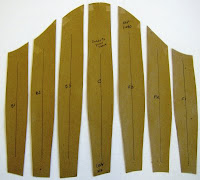
Just how many pattern pieces for a paned sleeve? I usually start with a basic one piece sleeve block. I then usually create a two piece sleeve and gusset from that so I have one ready.
A cuff or forearm pattern
A base under sleeve for the upper arm. This will keep the sleeve the correct length. It has a little ease where it joins to the forearm or cuff piece. It will also be a support for any netting we may use to keep the outer fabric in the shape we like.
A basic upper sleeve pattern reduced below the
 elbow to fit the forearm piece.
elbow to fit the forearm piece.This will used to develop the panes. I lengthened this pattern an amount I thought would be suitable, then drew in the panes. You need to allow some space between the panes on the pattern because they tend to acquire a bit of bulk as they are lined and bound, and you want them to fit after you've done all that work. I then traced the basic panes onto another sheet of paper and shaped them. The reason we don't leave them as straight panels is that they look awful like that. All patterns should have graceful lines, and straight lines rarely belong on the body. Straight lines tend to look flat, uninteresting and sometimes after sewing, hollowed out or concave. If you need a straight line look, you are better off starting with a slight convex shape in your pattern. (rigidity, straight lines, overuse of rulers = my pet peeves.)

 Lastly, a large pattern for the upper puff that is seen through the panes.
Lastly, a large pattern for the upper puff that is seen through the panes.





























